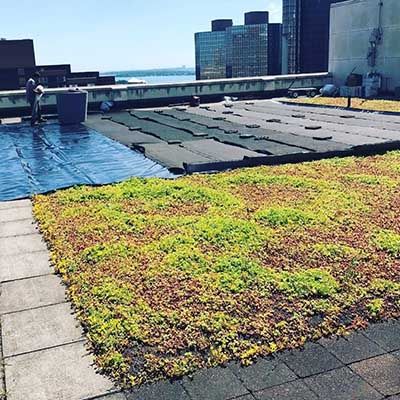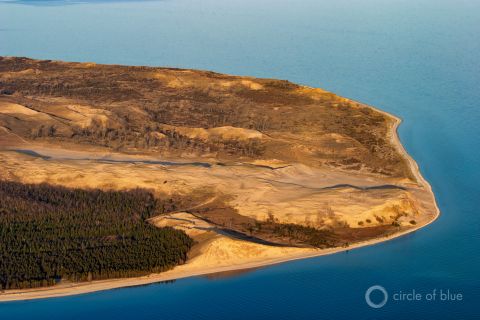
By Kelly House, Bridge Michigan, and Keith Schneider, Circle of Blue
The Great Lakes News Collaborative includes Bridge Michigan; Circle of Blue; Great Lakes Now at Detroit Public Television; and Michigan Radio, Michigan’s NPR News Leader; who work together to bring audiences news and information about the impact of climate change, pollution, and aging infrastructure on the Great Lakes and drinking water. This independent journalism is supported by the Charles Stewart Mott Foundation. Find all the work HERE.
The year is 2050, and you’re visiting family in Detroit.
Arriving, you grab coffee on the ground floor of a nine-floor building filled with offices and apartments, designed to house a growing Great Lakes city without pushing out longtime residents.
Around the corner, people gather for walks and picnics in a wetland park, one of dozens constructed around the city. With their wet meadows, flowers and gently winding trails, the parks absorb rainwater from frequent storms, reduce water treatment costs and alleviate the basement backups of water and sewage that once plagued Detroit.

Climate change experts say the Great Lakes region could experience waves of inmigration as climate change makes it harder to live in drier, hotter regions. But if Michigan is to successfully absorb all those newcomers, it must address the current and future threats climate change poses at home. (Photo courtesy of Andy Mcfarlane/Michigan in Pictures)
Heading north along Lake St. Clair and on to Lake Huron, homes are set back from the shore to allow room for erosion and flooding that come with the heavier, more frequent storms linked to a changing climate.
As climate change alters our world, Michigan’s bounty of fresh water — if managed smartly — could be the foundation of a thriving state economy and superior quality of life. This could be the Detroit of our future, part of a state that’s prepared for inevitable change.
The Great Lakes News Collaborative — composed of Bridge Michigan, Circle of Blue, Great Lakes Now at DPTV and Michigan Radio — noted in February that experts view the state, with its abundant supply of fresh water, as a likely refuge for climate migrants. Supercharged storms, drought, rising seas, heat, plagues and wildfires are likely to push people away from coastal areas and parts of the South and West. Milder summers, less fire-prone forests, and massive freshwater seas containing 20% of the world’s surface fresh water will almost certainly draw people to the safer Great Lakes states.
The collaborative’s reporting, in a series called “Ready or Not,” found that, in many cases, the coordinated, long-range preparation for climate change has not been done.

An Inhabitect employee installs a living roof in Detroit, Mich. Inhabitect is a company that works in the Great Lake region designing and building living roofs, natural shorelines, and rain gardens. (Photo Courtesy of Inhabitect)
The state still suffers from water pollution, for instance, in some cases with little power to punish those responsible. Our failure to prepare the state’s aging infrastructure for climate change has worsened flooding and imperiled water supplies.
But how might Michigan’s future look if we get it right?
Bridge Michigan and Circle of Blue interviewed experts in agriculture, water policy, climate adaptation, local government and business, asking them to envision what a climate-prepared Michigan might look like, and what it will take to get there. Here are some key takeaways:
Fewer vacant lots, more ‘garden cities’
Water is at once Michigan’s greatest environmental asset and its most obvious, persistent climate hazard. Scientists expect a warming globe to alter rainfall patterns in the state, bringing more intense storms like the one that flooded mid-Michigan and destroyed two dams in May of last year, leaving a $200 million repair bill.
One way to absorb all that water in a stormier future, said Sanjiv Sinha, senior vice president and national water resources director for Environmental Consulting & Technology, Inc., is to transform the landscape to store it.
And Michigan, whose biggest city has lost 70% of its population since 1950, leaving behind a glut of vacant land, “is in many ways primed for that change.”
Pre-industrialization, much of Michigan was covered in wetlands that served as nature’s sponges, absorbing rainfall. But as population and industries grew, large swaths were filled in for farms and development. Covering porous soil with concrete and asphalt sends rain streaming into streets, sewers and neighborhoods, where it sometimes floods homes, overtaxes infrastructure and raises water treatment costs.
“We can turn back the clock, in terms of urban development,” Sinha said, transforming cities with vast acreages of paved land that no longer serve a purpose, from Detroit to Milwaukee, into “garden cities” where large urban parks double as stormwater retention ponds.
That would also help remedy the dearth of parkland in cities like Detroit, which has fewer acres of parkland per-person and spends less on parks per-person than other cities with similar population densities. And while the up-front costs of buying new land or renovating existing parks can be high, communities save big on water treatment by “treating the rain where it falls,” allowing natural filtration in the earth to strip away sediment and toxins, Sinha said.
Some of that work is already happening. In Detroit, the city water department hiked drainage fees to raise $150 million for stormwater management, prompting lawsuits from some residents while sparking others to replace hard surfaces with green roofs and rain gardens. As Lester Graham of Michigan Radio reported in an earlier installation in this series, Grand Rapids has made similar strides.
The controversy over water rate hikes in places like Detroit and Flint points to a key challenge: Investing in stormwater management is costly. To absorb the moisture from a wetter future, Sinha said, Great Lakes cities must pursue such efforts on a mass scale, on the order of tens of millions of dollars of investment in a single city. That investment is of course not limited to the Midwest, with cities like Miami likely needing billions of dollars to build sea walls against surging waters.
“We simply cannot ignore the infrastructure overhaul that we do need to do,” Sinha said, pointing to the massive COVID-19 recovery dollars headed to U.S. cities and anticipated federal infrastructure investments as possible sources of funding.
Anika Goss, chief executive officer of Detroit Future City, the planning and development nonprofit that has advocated for green infrastructure, said projects like the Dequindre Cut greenway — a two-mile walking and biking path along a former railway line — can serve as a model for future action. There, private investment helped pay for more public open space and a non-motorized transportation network while providing stormwater storage and drainage benefits.
“Cities can’t do it alone,” Goss said. “There has to be a local, state, federal and business response to this.”
Related stories on Great Lakes Now:
Flooding Tells ‘Two Different Stories’ In Michigan
Green Infrastructure: Cities around the Great Lakes plan for a changing future
Rights vs. Regulations: When it comes to septic system codes, property rights remain a big barrier
Fewer septic systems, more separated sewers
Michigan has among the nation’s highest share of residents who rely on septic systems, at 35%. It’s also the only state in the nation that lacks a statewide sanitary code.

Jacob Stachnik, a worker at Concrete Service in Traverse City, Michigan, stands on a stack of septic tanks. Water pollution and diseases linked to septic system failures are becoming more problematic in the United States. (Photo Credit: J. Carl Ganter / Circle of Blue)
That combination is fouling Michigan’s waters. One study by Michigan State University researchers found septics to be a major culprit in fecal pollution in state waterways.
Michigan’s lack of oversight “is the height of ignoring a problem,” said Charlotte Jameson, program director of drinking water, energy and legislative affairs with the Michigan Environmental Council, a nonprofit coalition of environmental and policy groups.
Climate change could worsen the problem by warming waters, which creates ideal conditions for bacteria and algae to proliferate. Experts say a widespread effort to fix existing septics and disconnect others is the best way to solve the problem before climate change makes it worse.
Gov. Gretchen Whitmer has earmarked $35 million in her proposed 2021-2022 budget to help Michigan residents fix failing septic systems. But it’s unclear if the money will make it into the final budget. And long-term, Jameson said, it will be cheaper and more effective to get more people off septics, and onto public water treatment systems.
“No septic system,” Jameson said, “is going to be better from a water quality perspective than a water treatment system.”
Ohio is already making that transition. Several Ohio cities have been gradually disconnecting septics and moving residents onto sanitary sewer systems under state EPA orders.
Attempts to address Michigan’s lack of state-level septic regulation have faltered, and as Great Lakes Now’s Natasha Blakely has reported, there is little immediate appetite in the legislature to consider creating a septic code for Michigan.
Grain, bean and veggie farmers

A farm set back from the eroding shoreline of Lake Michigan (Photo Credit: J. Carl Ganter/Circle of Blue)
As the American South and West grow dryer, the country may eventually rely more heavily on the Great Lakes region for food.
Growing all that food while reducing the farm-caused nutrient pollution that fouls Lake Erie and other waters present a challenge.
Joel Brammeier, chief executive of the nonprofit Alliance for the Great Lakes, sees a more diverse agricultural sector as part of the solution. The Great Lakes region can reduce farm pollution by growing fewer monocrops of corn and soy, and more diverse rotations of grains, beans and vegetables.
And if Michigan farms don’t change course?
“Then we end up with warm, dirty water that people can’t drink,” Brammeier said.
Research has also shown that planting a more diverse mix of crops would help reduce the nutrient pollution in Lake Erie.
Some Great Lakes farmers are already experimenting with such practices. But as Bridge reported, it’s far from clear whether such innovation is possible on a mass scale without stronger regulations to hold growers accountable for polluting.
One potential solution, said Conan Smith, president and CEO of the Michigan Environmental Council, is to work with the food industry to develop new markets for more environmentally-friendly crops, so farmers have more incentive to grow them.
Warming climates and other factors will also push more Great Lakes farmers to irrigate their crops, which could strain water supplies. In hopes of abating that trend, scientists at The Land Institute in Salina, Kansas, are developing perennial seed crops of wheat, corn, soybeans, sunflower, and beans that behave like prairie plants, growing on rain and nutrients produced naturally by the fertile soil. If successful, these crops could drive Michigan agriculture to new standards of production and profitability, says Wes Jackson, the Institute’s founder.

This aerial photo shows the undeveloped shoreline of the Sleeping Bear Dunes National Lakeshore on Lake Michigan. (Photo Credit: J. Carl Ganter/Circle of Blue)
Smarter shoreline development
Humans are drawn to water. But last year brought one wakeup call after another about the folly of building too close to Michigan’s shores.
The Great Lakes rose to record highs, inundating some shoreline communities, eroding ground underneath others, and inflicting a heavier toll on black, brown and poor residents. Huge numbers of coastal landowners obtained permits to armor Michigan’s coasts with boulders, an effort that will ultimately make erosion worse by scouring more sand out from under and around shoreline barriers.
Heavy rainfall also caused inland flooding, from the downpour that caused the Midland dam failures, to flash floods in metro Detroit and Traverse City, requiring expensive repair and recovery efforts.
To avoid similar problems in the future, experts said, Michigan and the nation must reconsider policies that allow people to build homes close to shore or in flood-prone areas. And the state must consider investments to gird existing homes, dams and bridges against more powerful storms.
Smart coastal communities of the future will have setback requirements built into local zoning codes, prohibiting anyone from building within a certain distance of the shoreline. And it will be widely acknowledged that, even if your home is comfortably far from the waves today, your property will eventually be lost to the lake, said Richard Norton, a professor of urban and regional planning at the University of Michigan’s Taubman College of Architecture and Urban Planning.
“For folks who believe strongly in private property rights, there’s kind of a gut reaction that of course we have to let people protect their homes,” Norton said. But as climate change makes coastal risks more pronounced, we’ll have to rethink that instinct, he said.
As Bridge has reported, some communities are already taking steps in that direction.
In places where retreating from the shoreline is not an immediate option, Norton said, residents and government leaders can plan now for how to cover the cost of maintaining shoreline infrastructure, from buildings and roads to drinking water treatment plants.

The sun rises over a wetland near Interlochen, Michigan. (Photo Credit: J. Carl Ganter/Circle of Blue)
Look to our past for inspiration…and caution
Michigan has been influential in projecting an optimistic view of the American future.
In 1939, General Motors-sponsored the Futurama exhibit at the New York World’s Fair, a huge diorama of a highway-heavy, congestion-free, car-dependent, time-efficient, leafy green urban and suburban pattern of civilization that no one had seen before. Under this vision, an estimated 10% of Americans would be loaded into pods and transported by conveyor across a landscape of innovation and creativity that would become the economic and cultural foundation of the “drive-thru” century.
What astute observers of that time recognized — among them Lewis Mumford and Walter Lippman — was that GM’s new American geography needed enormous public investments in the roads, sewers, education, research, planning and industrial infrastructure to make it reality.
The vision, though, of an airy, prosperous, shining, and mobile American way of life was powerful and eminently achievable. In the next two decades, voters elected to Congress and the White House lawmakers of both parties who cooperated in steadily enacting big and expensive bills — the GI bill to educate military veterans, the 1956 Highway Act to start the Interstate System, water and sewer spending bills, research grants for engineering, just to name a few — that changed how America looked and functioned.
The irony is this very vision — a sprawling, resource-intensive lifestyle — is now exactly what experts say we must undo. But the project showed that when prompted by opportunity or threat, Americans can set and achieve substantial goals.

The sun rising over Lake Superior from Sugarloaf mountain. (Photo Credit: J. Carl Ganter/Circle of Blue)
A plan for change
Are we as capable of pulling that off as we were in the 20th century? Pessimism often dominates conversation about America’s future. In December 2018, Pew Research Center asked 2,500 adults about their views of America in 2050.
“Majorities predict a weaker economy, a growing income divide, a degraded environment and a broken political system,” the survey’s authors wrote.
Boldly addressing our region’s future as a climate refuge may receive a healthy dose of skepticism from communities that have felt abandoned by past economic decline or outmigration that worsened racial and economic divisions, said Vivek Shandas, a professor of urban studies and planning at Portland State University in Oregon who specializes in climate adaptation.
“It can be very impactful when a group of people from a different part of the country move into a place,” Shandas said.
Residents may fear gentrification by wealthier newcomers, a phenomenon that played out over the “great reshuffling” of the COVID-19 pandemic as people fled cities, buying up houses in places like northern Michigan and driving up costs.
Shandas said it’s also possible for conflict to arise when newcomers move in, changing the cultural dynamics in a community.
The communities that fare best will have thought early-on about what they want their climate future to look like. They will have grappled with questions about how to absorb newcomers without displacing longtime Michiganders, how to foot the bill for climate preparedness, and what to do if we aren’t prepared when disaster strikes.
There’s an added benefit to starting those conversations now, said Monica Lewis-Patrick, chief executive of the water justice nonprofit We the People Detroit. The threat of climate change calls for planning that touches nearly every corner of society. But it also presents an opportunity to rethink how to build communities around a goal of eliminating the inequality that is baked into our current society.
Lewis-Patrick has long called for an end to “water apartheid,” her term for the unequal access to clean, affordable water, as evidenced by events with a disportionately impact on lower-income communities of color, including Flint’s lead-tainted water crisis and episodic Detroit water shutoffs.
“There’s a saying,” she said. “Either we’re all going to pay, or we’re all going to pay.”
Catch more news on Great Lakes Now:
Water Access: As moratoria on shutoffs end, old problems return to the forefront
Great Lakes Water Diversions Could Be More Numerous
In flooded Michigan neighborhoods, who should pay for sea walls?
API key not valid. Please pass a valid API key.Featured image: An ultralight glides along the shores of Lake Michigan. (Photo Credit: J. Carl Ganter/Circle of Blue)





